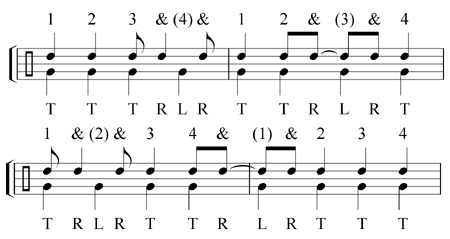Musicarta Beat and Rhythm Workbook
Tapping Exercises
Module Two - Anticipation
This module is Part Two of the Musicarta Beat and Rhythm tapping exercise series. If you have not worked through
<a href="http://www.musicarta.com/beat-and-rhythm_4.html" target="_blank">Part One</a>, please do so before continuing. Part One has an explanation of the beat maps you will find in this module, the full Beat and Rhythm series table of contents, and the ‘Ways to use this material’ section.
Anticipation
Anticipation is often used to make popular music sound more exciting.
Anticipation means pulling a note forward and playing it ahead of the beat it would be played on in the ‘straight’ or ‘square’ version of the music.
You have seen the first bars of the next four examples before, in the ‘Two quavers in a bar’ section of <a href="http://www.musicarta.com/beat-and-rhythm_4.html" target="_blank">Part One</a> of this series. We will use them again to practice anticipation.
First, review the rhythms.
(bring in table from B&R4)Make sure you can tap these out confidently before going on.
In
the following examples, the first bar is ‘straight’ and the quaver which
is about to be pulled forward (anticipated) is indicated with a curvy
arrow. In the second bar, the quaver has actually moved. The audio clip
plays exactly what is written.

|
|

|
|

|
|

|
|
Look closely at the beat maps to see how the arrowed tap has been pulled forward. Tap out just the right hand (stems up) part on its own if you like.
You can hear that the anticipation makes the beat and rhythm of the second bars lighter and more interesting. There are more ‘ands’ in the counting, and fewer T-for-togethers.
Now tap out the second bar rhythm only.

|
|

|
|

|
|

|
|
Combined patterns
Here are some combined two-quavers-in-a-bar patterns. The first and second bars are not the same. You are going to anticipate the first of each pair of quavers, as indicated by the curvy arrows.
The examples are in pairs – straight, then anticipated. Try to ‘get’ the anticipated quaver rhythm before listening to the audio file to see if you are right.

|
|

|
Use the counting and TLR analysis of the bottom example to help you tap out the rhythm before listening to the audio file. Look at the first beat map while you listen to the audio file to see how the anticipation works.

|
|

|
Note that, whenever you anticipate a
T-for-together in the 'straight' example, it becomes a R–L (right then left) in the lower, anticipated version.

|
|

|
Creating rhythmic studies
Beat is music in its own right.
You can create your own rhythmic studies by combining two or more of these examples. Listen to the audio-only example and try to establish which of the two examples from the tables above are used in the combination.
Write down the beat map. The correct beat map is shown at the end of the module.
Creating your own rhythmic studies and writing beat maps for them is excellent practice at writing down music you hear and want to play – or your own compositions.
Four-quavers-in-a-bar patterns
Next, here are some four-quavers-in-a-bar patterns to work on

|
|

|
|

|
|

|
|
Here are some combinations of these bars.

|
|

|
|

|
|
Make sure you can tap them out well before you go on to anticipating the beats.
Adding anticipation
Here are the patterns from two tables above with the quavers to anticipate marked with curvy arrows. The audio clip in the table is for the ‘anticipated’ version which you are going to make by pulling the quavers forward.

|
|

|
|

|
|

|
|
Now here are the anticipated patterns written out properly with their matching audio files.

|
|

|
|

|
|

|
|
Alternative left hand patterns
For a challenge, play these right hands over one of the alternative left hand patterns from the first module in the series.

|
|

|
|

|
|

|
|
Here is a riff based on one of the patterns above:
Work out which one of the rhythm patterns in the table above it uses.
Hear is the beat map for the rhythmic study (audio) above.

|
The worked-through counting/TLR-only samples
The counts only
TLR only
The next module in this series encourages you to internalise this highly empowering way of looking at beat and rhythm by having you work from counting and TRL analysis all the way back to the riffs they're drawn from.
|
OUT NOW! |
THE MUSICARTA BEAT & RHYTHM WORKBOOK At last! An effective approach to keyboard rhythm & syncopation skills. Learn more! |
ONLY $24.95! |
The MusicartaA methodical approach to keyboard syncopation for
|
PUBLICATIONS
exciting keyboard
creativity courses
CHORDS 101
WORKBOOK

~HANON~
video course

Musicarta
Patreon
PENTATONICS
WORKBOOK
video course

Creative Keyboard
video course

BEAT AND RHYTHM
WORKBOOK

- Volume 1 -

12-BAR PIANO
STYLES WORKBOOK

MUSICARTA MODES
WORKBOOK

PIANO STYLE

CANON PROJECT
video course

VARIATIONS
video course


- Piano Solo -
video course

- Piano Solo -


YouTube playlists





 THE LOGO
THE LOGO
